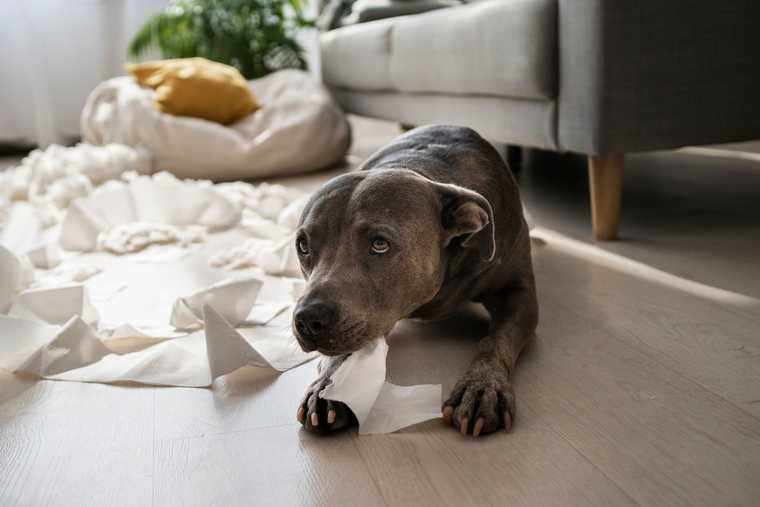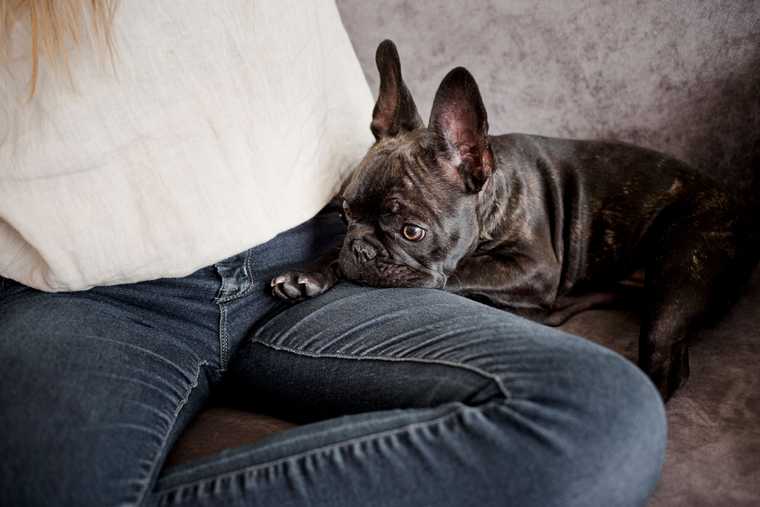A Guide to Submissive Urination in Dogs

By
Anastasiia Petrovska Updated on |Reviewed by
Karen PiwinskiDogs communicate with their owners in many ways – whining, barking, rolling over, or even peeing. Submissive peeing in dogs can frustrate pet parents, especially when it happens frequently.
This behavior is more common in puppies, though some adult dogs may do it in stressful situations. Understanding what causes submissive peeing and its signs helps you recognize it and respond the right way. Keep reading to learn how to get a dog to stop peeing when scared.
What Is Submissive Urination in Dogs?
Submissive urination is an instinctive response to nervousness or fear. Experts from the Morris Veterinary Center say that such behavior is common in the canine world. It can be a sign of submission to a leader or a reaction to a perceived threat. A puppy pees when scared, though most puppies outgrow it after one year of age.

It’s important to remember that spaying a female dog can be among the reasons for submissive urination. In this case, peeing when scared can continue even into adulthood.
Small adult breeds are also more likely to pee when nervous than medium-sized breeds. Regardless of age, sex, or breed, submissive peeing is always caused by nervousness, fear, and anxiety.
It is important to understand your individual dog’s triggers that lead to submissive urination. This way, you can work on these in a positive manner to teach the dog that they’re not scary.
Common Triggers of Submissive Peeing
Dog owners should know what situations can trigger this behavior. Triggers for submissive urination include:
- Direct eye contact with other pets that are acting aggressively or are too loud
- Appearing larger or towering over the dog
- Loud and aggressive voices
- Arguments between people
- Sudden loud noises (sirens, construction work, explosions)
- Unfamiliar people, places, or situations
- Being forced into a situation (being pulled out of a crate or being pulled into a car).
Submissive urination in dogs is often confused with excitement urination. Experts from the UC Davis School of Veterinary Medicine emphasize: excitement urination is caused by a strong feeling of joy and excitement, which a dog simply can’t contain. On the contrary, submissive urination is caused by fear and anxiety. Both can occur during walks or greetings. However, the signs of submissiveness are different than those for excited urination.
Why Do Dogs Pee When Scared?
Submissive urination is an instinctive behavior, but it can be caused by specific reasons.
1. Medical issues
Always rule out medical problems (urinary incontinence, UTI). Spaying, especially early spaying, can also cause submissive peeing in dogs. Schedule a visit with your dog’s vet to get a health check-up. Especially if peeing continues for over a year or other symptoms appear with changes in the dog’s behavior.
2. Lack of control due to incomplete house training
When you get a dog, especially a small puppy, you need to provide proper potty training for them. Puppies under 12 weeks don’t yet have proper bladder control. Adopted dogs can also have a lack of bladder control if they didn’t learn a potty routine. Feeling insecure in a new environment can also be a reason a dog urinates out of fear.

3. Age
Submissive urination in puppies is a normal situation for those under 12 months old. Female puppies are more likely to urinate in the presence of a more authoritative person. This behavior shows that dogs are reacting to stress, which they can’t control.
4. Separation anxiety
When a pet parent leaves, their dog may feel lonely and anxious. This stress may cause submissive peeing. In other words, your dog pees when scared that you’re leaving.
5. Trauma
Unfortunately, some dogs have past trauma from abusive previous owners, who punished or scolded them excessively. The dog learns that unintentionally from this traumatic experience. Over time, the dog learns to pee as a way to avoid punishment. Even though it can frustrate the owner even more, and it can become a vicious cycle.
Remaining calm and neutral around the dog can help them overcome submissive urination, as some dogs can even become scared when a person is acting friendly and attempting to pet them. Advocate for your dog and let others know they’re shy and may not want attention.
6. Genetics
Certain dog breeds, such as German Shepherds, Cocker Spaniels, and Golden Retrievers, have a genetic predisposition to submissive urination. Some data confirms that certain breeds are more prone to separation anxiety than others. According to these studies, Golden Retrievers are more likely to develop separation anxiety than other dog breeds.
Signs of Submissive Urination
Here are behavioral signs that can help you spot submissive urination. They include:
- Lowering of the head and body
- Tucking the tail between the legs
- Flattening the ears
- Avoiding eye contact
- Cowering or rolling onto the back to expose the belly
- Urinating while in these submissive postures.
Such behavior, causing fear or anxiety, makes submissive peeing in dogs very likely.

How to Stop a Dog from Submissive Peeing?
Once you have identified that your dog urinates because of fear or anxiety, the question is how to stop it.
1. Consult a vet
Submissive peeing can be a disguise for a real medical issue. Make sure to consult a vet in order to exclude potential medical reasons, especially if there are no submissive signs and other symptoms of poor health are present.
2. Beware of triggers
Knowing what triggers certain behavior of your dog can help you to manage it better. In case of submissive urination, aggressive voices or loud noises, arguments between people can make your dog feel anxious and nervous. Check out the full list of triggers in the section above to avoid situations causing submissive behavior.

3. Avoid threatening postures
Certain dog owners’ postures or gestures may scare the dog. Thus, do not lean over suddenly or approach head on. This may make your dog feel insecure and scared, which will lead to submissive peeing as a form of protection.
4. Avoid punishment
Punishment usually makes things worse – even well-balanced dogs can become anxious. Remember: punishment never helps the dog learn in a positive and safe way. Instead, it just strengthens their anxiety and fear, which then leads to submissive peeing.
It’s important not to punish or scold your dog for submissive urination; they’re not trying to be disobedient, and correcting them can scare them more and may make the behavior worse.
5. Build confidence and create a consistent routine
A consistent routine is essential for the dog to learn and behave better. Regular training, including basic obedience and mental training, can help build a more confident dog. Gentle pats and calm interactions can enhance training results and build a more trusting relationship.
6. Reinforce calm behavior with praise and treats
Positive reinforcement builds relationships based on love, trust, and respect. Always reward calm behavior, give praise, and small treats. This teaches your companion to stay calm and helps build trust.
7. Be patient
Progress takes time. Be patient and try to understand your dog’s personality and needs. With time, you’ll learn to provide the reassurance the dog needs and communicate better.
Wrap up
Peeing from fear or anxiety isn’t a bad behavior – it’s a deep-rooted instinct and a way to cope with emotions. Submissive peeing in dogs has specific signs; it’s caused by fear, as opposed to excited peeing.
Build your dog’s confidence through a consistent routine and praise. Patience and positive reinforcement will help your dog overcome anxiety-based urination and become a confident pet.



